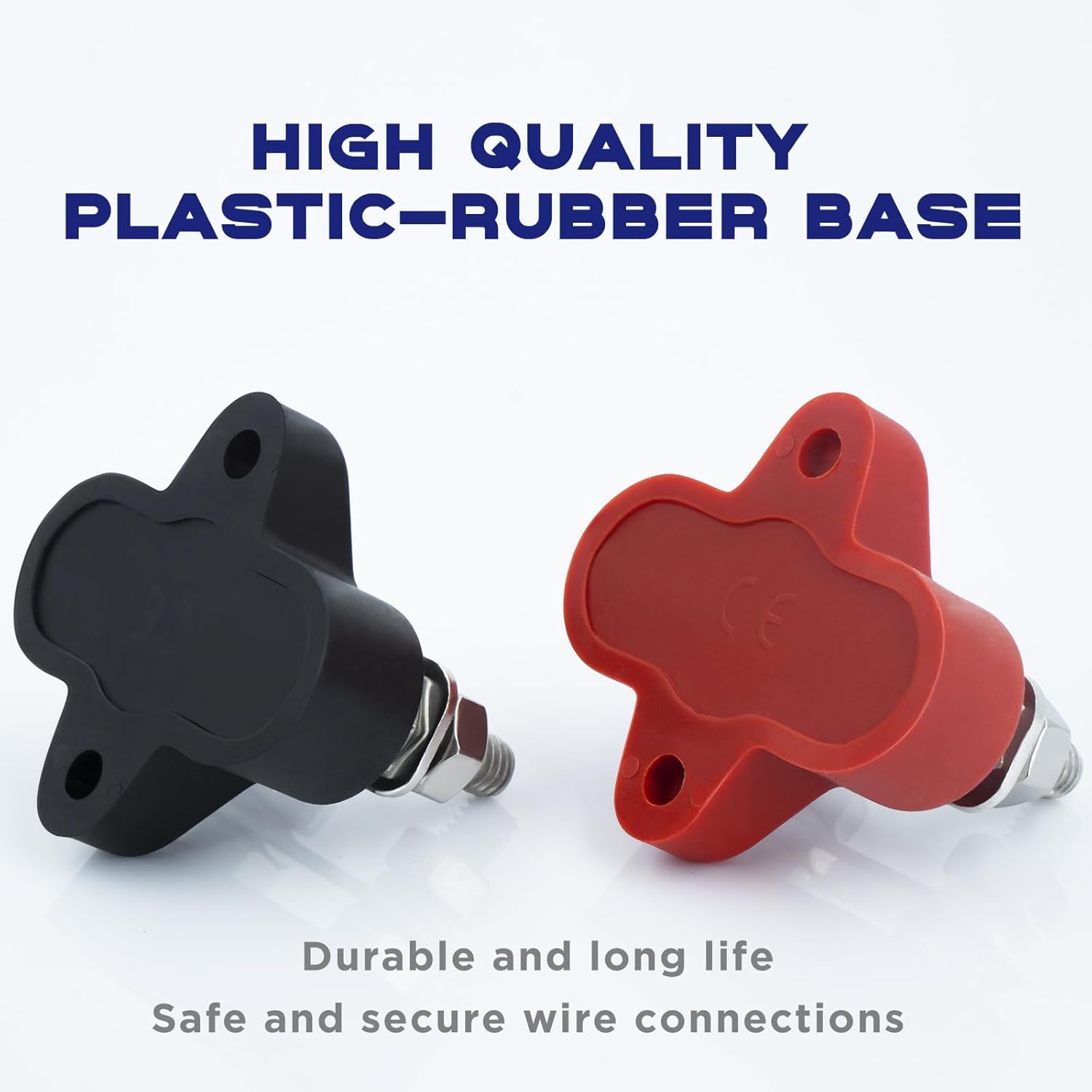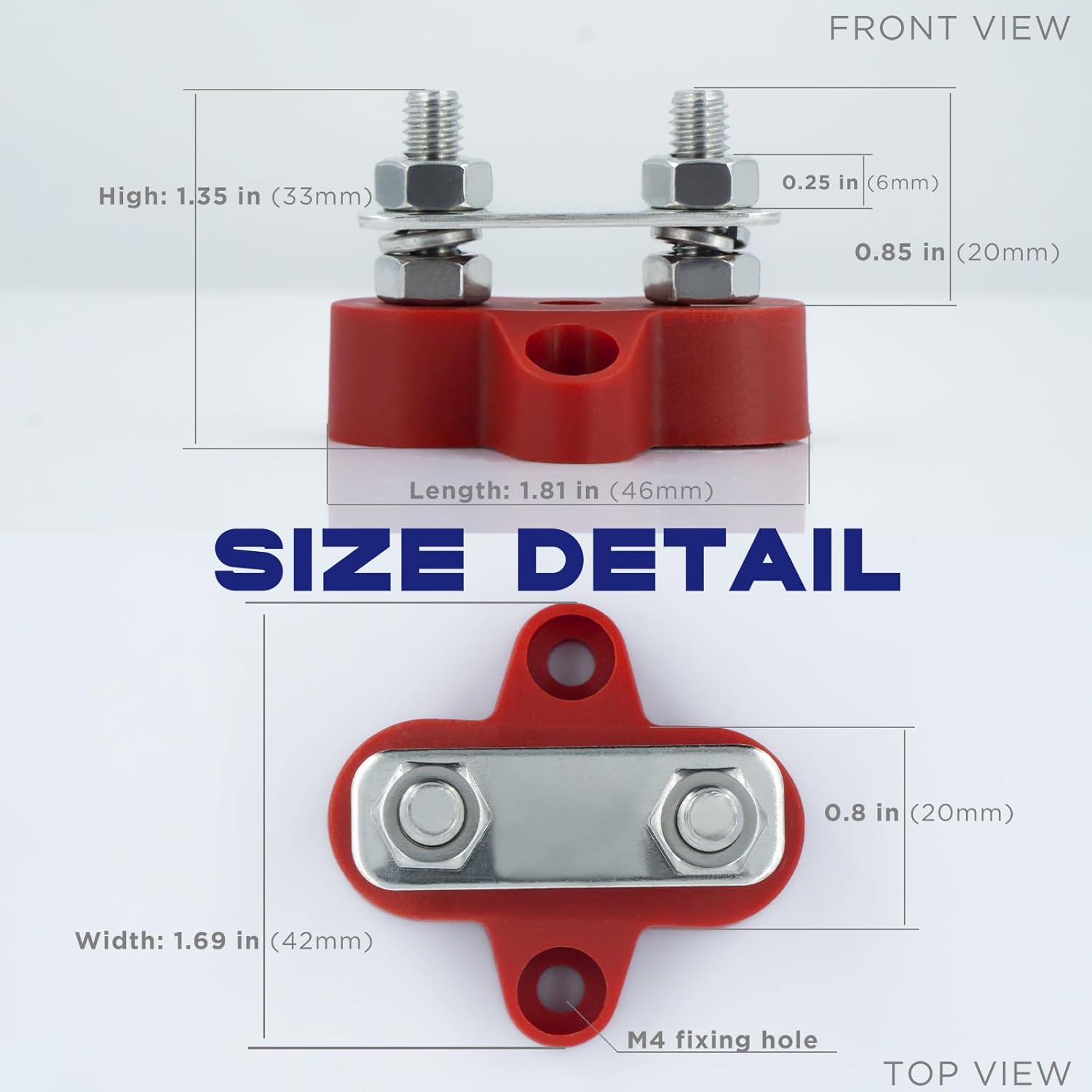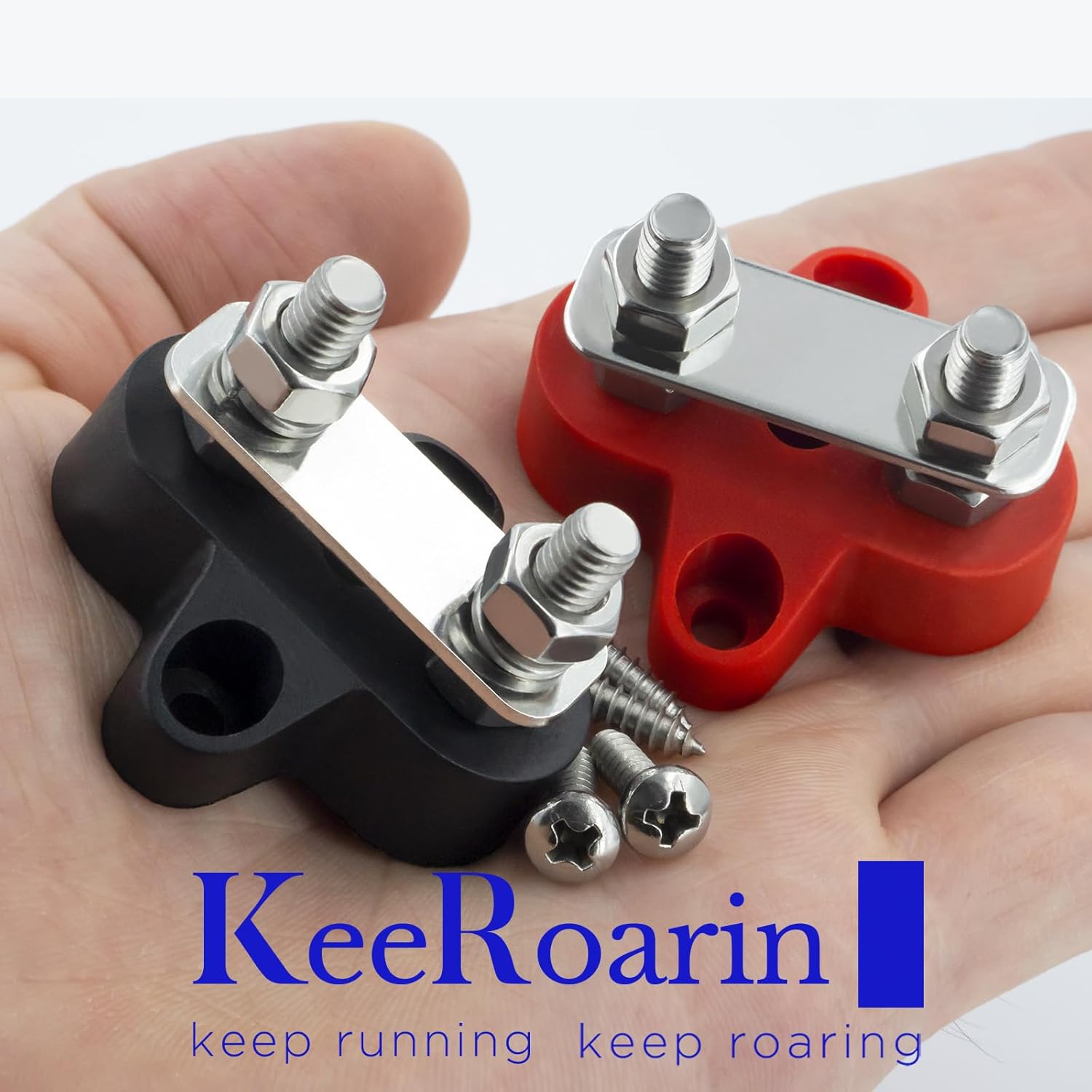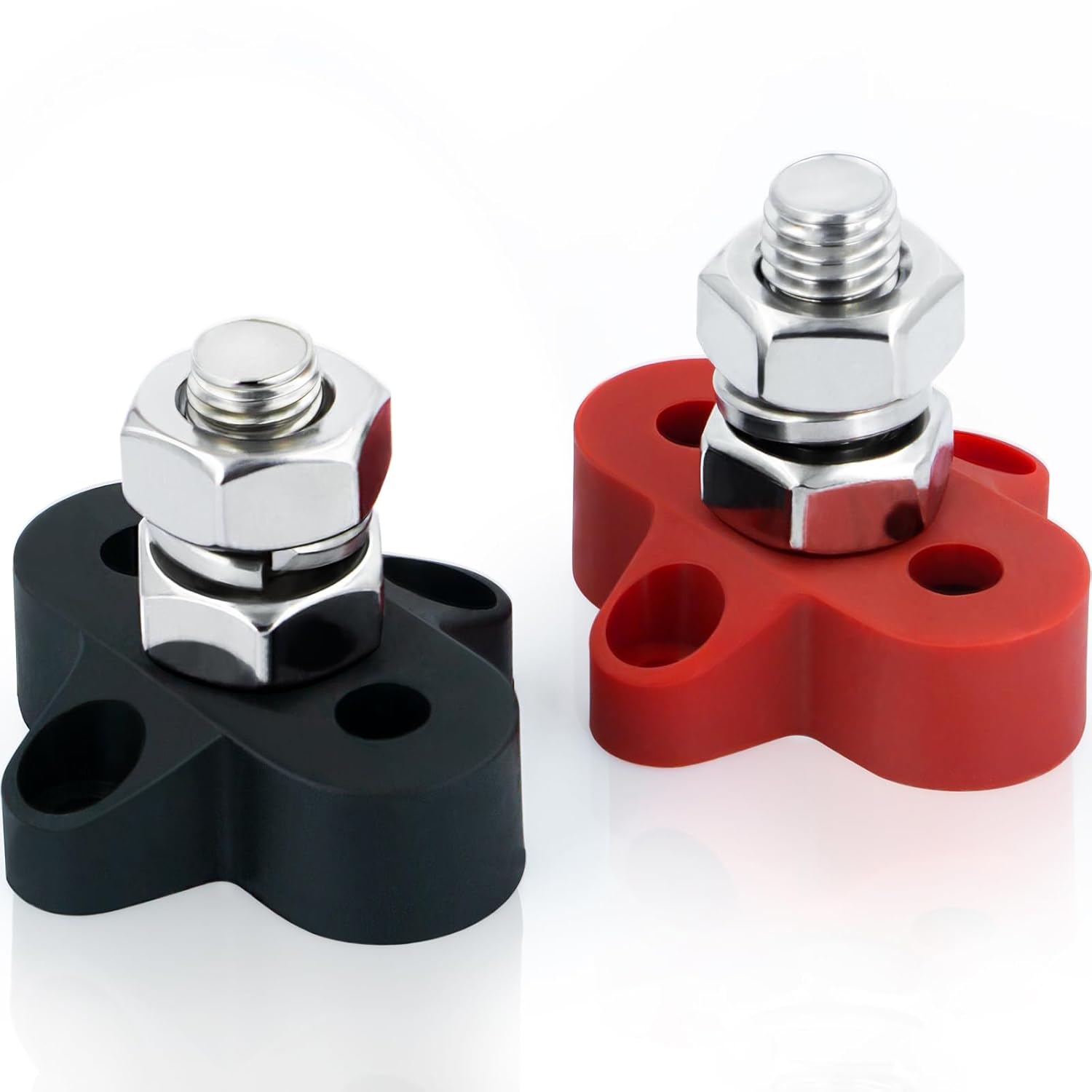### Descrição do Produto
O Terminal Block de Distribuição de Energia 1/4″ é a escolha perfeita para quem busca uma solução robusta e eficiente na gestão de energia em veículos automotivos, embarcações, trailers e equipamentos industriais. Com capacidade para suportar tensões de 12V a 24V e uma tensão máxima de trabalho de até 48V DC, este bloco de terminais é ideal para aplicações que exigem alta performance, com uma capacidade de até 200 Amp.
#### O Pacote Inclui
– 1 x barra de distribuição positiva (vermelha)
– 1 x barra de distribuição negativa (preta)
– 4 x parafusos de fixação
#### Dimensões
– Comprimento: 1.81”
– Largura: 1.7”
– Altura: 1.38”
– Altura do bloco de distribuição com duplo pino de 1/4” (M6): 0.87”
#### Alta Qualidade
Construído com pinos de energia de aço inoxidável de 1/4”, este terminal block é projetado para resistir à corrosão e ao desgaste, garantindo uma longa vida útil. A base é feita de plástico retardante de chama, proporcionando segurança e resistência mecânica em ambientes adversos.
#### Várias Utilizações
Este bloco de distribuição de energia é amplamente utilizado para personalizar sistemas elétricos em carros, barcos, caminhões, veículos RV, trailers marinhos e em diversas aplicações industriais. Ele permite a realocação de baterias, extensão de distâncias de fiação e organização eficiente da fiação.
#### Design Fácil de Usar
As barras de distribuição são codificadas em cores, com vermelho para a barra positiva e preto para a barra negativa, facilitando a identificação e a instalação. O design com pinos de barra de distribuição permite a terminação de cabos para múltiplas conexões, simplificando a manutenção.
### Instruções de Uso:
Para instalar o Terminal Block de Distribuição de Energia, inicie desconectando a bateria do veículo ou equipamento. Fixe o bloco de terminais na superfície desejada utilizando os parafusos fornecidos. Conecte os cabos de energia à barra positiva (vermelha) e os cabos de aterramento à barra negativa (preta), assegurando que as conexões estejam firmes. Utilize a codificação de cores para facilitar a identificação das conexões. Após a instalação, reconecte a bateria e teste o sistema para garantir que todas as conexões estejam funcionando corretamente.
### Características do Produto
– Material: Pinos de aço inoxidável e base de plástico retardante de chama.
– Capacidade: Suporta até 200 Amp e tensões de até 48V DC.
– Dimensões Compactas: Facilita a instalação em espaços reduzidos.
– Cor Codificada: Facilita a identificação e organização da fiação.
– Versatilidade: Ideal para uma ampla gama de aplicações em veículos e equipamentos industriais.
### Perguntas Frequentes (FAQ)
Pergunta: Qual é a capacidade máxima de corrente que o terminal block pode suportar?
Resposta: O terminal block pode suportar até 200 Amp, tornando-o adequado para diversas aplicações de alta potência.
Pergunta: Posso usar este terminal block em ambientes marinhos?
Resposta: Sim, o terminal block é projetado para ser resistente à corrosão, tornando-o ideal para uso em barcos e outras aplicações marinhas.
Pergunta: É fácil de instalar?
Resposta: Sim, o design do terminal block permite uma instalação simples e rápida, com parafusos de fixação incluídos para facilitar a montagem.
Pergunta: Quais são as dimensões do produto?
Resposta: O terminal block possui um comprimento de 1.81”, largura de 1.7” e altura de 1.38”, com uma altura adicional de 0.87” para os pinos de 1/4” (M6).
Pergunta: O que vem incluído no pacote?
Resposta: O pacote inclui uma barra de distribuição positiva (vermelha), uma barra de distribuição negativa (preta) e quatro parafusos de fixação.
 Frete Grátis em todos os produtos
Frete Grátis em todos os produtos


















Robert Hare –
I love power distribution. Car audio is a hobby of mine, as well as adding toys to my Jeep, so I’m constantly redesigning my power layout. I decided to run a main power line to my amp board for my amplifiers and gadgets to feed from rather than independent power lines, so I needed a terminal block for them to feed. My amp board has very limited space and my larger four-post distribution blocks are too big, so I needed a more minimal option. When I saw these available I jumped on them.
These are tiny!!! I was shocked by how small they are. This is perfect for my situation! These are small enough to fit almost anywhere (see my pictures, pygmy hamster included for reference) and still have beefier posts. Now these aren’t the toughest distros you’ll find, but they’re pretty solid. My only complaint is that when I opened the bag the bottom plate of the negative terminal fell out exposing the bottom of the bolts (and these are just regular hex-head bolts). I may epoxy this to the bottom.
Overall I like these little terminals, but I’m a little leery of the bottom plate falling away, so I removed a star.
Remington –
I got these to make a wire connection in our RV. They are exactly as stated, heavy duty, great quality, and suited my purpose well. I like the included mounting screws as well. I wouldn’t hesitate to order these again.
Wired Fuzzy –
I haven’t attempted to test the AMP ratings of these blocks since I am only using them in my 5th wheel camper, so they only need to be able to handle 30-amps. With that said, I am sure they can handle more than that but pushing them to their rated 200-amp rating might be pushing it a bit. But, if you are pushing 200-amps and purchasing $12 distribution blocks, then I have to seriously question your logic since that is a TON of amps.
For my purposes, these are working great. I have a dual LifePO4 batter setup in my camper, each battery has quick-disconnects so I can easily remove them when I store my camper. Therefore, I have everything wired into distribution blocks (three of them at this point), one of which is THIS distribution block. The entire setup works great for me.
az-rosie –
Good distribution posts for linking and/or expanding some wiring set ups.
These were supplied with mounting screws. They seem to function fine in areas with no substantial risk of anything falling on top of each post to create an arch to the opposite side of power. My regular preference is to have some kind of cover over the posts, but there are certainly applications where that just might not be necessary. Decent price for both red and black colored posts.
Al –
These are basic two post terminal blocks to make wiring a basic 12V battery power system a little simpler. They appear well constructed. The posts are firmly anchored in the plastic bases. All hardware appears durable and adequate for the uses described. I have not tested their ability to safely carry the stated limiting 200A current.
az-rosie –
The design of this distribution block is a little bit light for the cables you usually associate with 5/16″ studs… The plastic parts bend under the typical torque applied to these studs.
Might want to save these for use with lighter cables like 10-12ga.
Corey –
This is a set of simple terminal blocks for connecting to, or branching out from, your positive and negative battery terminals/feed cables. These are well made to insulate the connections from the mounting surface, and the threaded posts and nuts fit as they should for a 5/16″ terminal hole, and can be tightened down sufficiently firmly without stripping or breaking the base. They come with 4 small screws to attach the base to your mounting surface. I wanted to use some very small allen bolts and self locking nuts instead, and the mounting holes in these were a bit too small,. Although there is not a lot of meat around the mounting hole area in the base, I was able to drill them out with a slightly larger drill bit, and then countersink them with a slightly larger yet bit so they were just open enough to allow my small allen head bolts to work and sit flat on the base mounting holes. They work as intended, and seem well enough manufactured to get 5 Stars, and a recommendation as being good enough quality and value to purchase them.
S.F. –
The Bus Bar Terminal Block kit comes with two terminal blocks which are colored red and black to match the red power and black grounding wires. The terminals, along with their plastic housing, feel solid. The package also includes mounting screws that can be easily screwed into a piece of wood.
Although the description mentions that it’s for a 12V system, I don’t see why it wouldn’t also work for a 24V or 48V system. The main consideration is whether it can handle high currents, which I believe this bus bar can easily manage. Typically, the higher the voltage of the system, the lower the current draw for the same wattage. The power (wattage) is calculated as the product of voltage (V) and current (I), represented by the formula:
Power (wattage) = Voltage (V) × Current (I)
Overall, it’s a nice product.